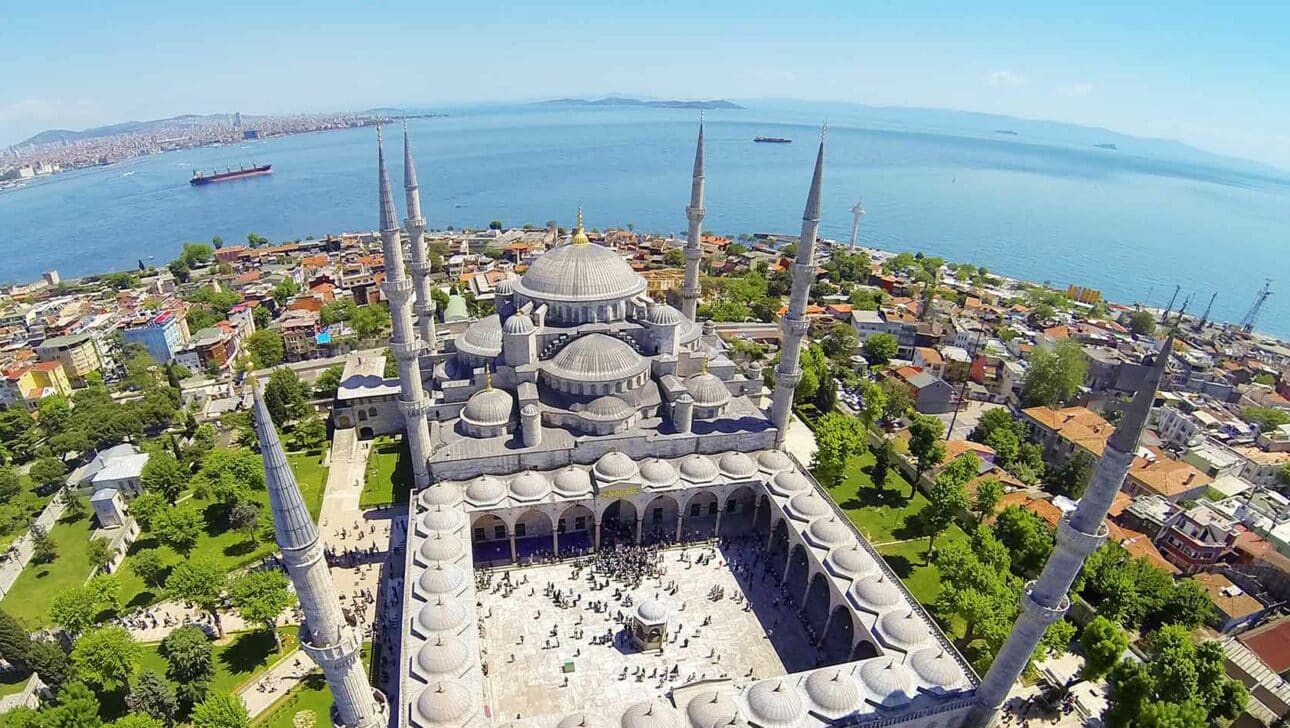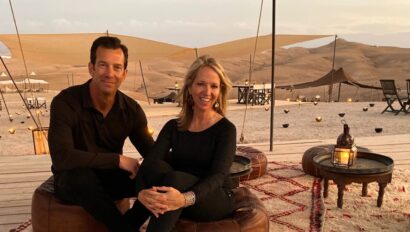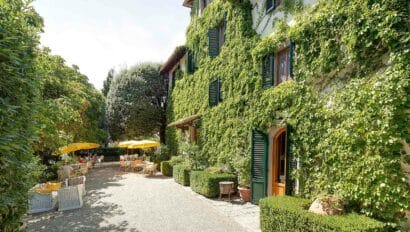In this multi-layered and exocit corner of the world, moving with the rythms of local life is as simple as tuning into your own inner frequency.
The quiet serenity of the Sultan Ahmed’s hallowed interior melts away as we cross its threshold into a grand, open-air courtyard and are swept up by a wave of frenetic activity in Istanbul’s Sultanahmet district. Car horns honk, Arabic pop music thumps from the speakers of a nearby shop and a bright tapestry of people floods past. We see men in business suits, old women in hijabs. A 20-something gal in Lululemon attire and Nike shoes brushes by a pack of her contemporaries dressed in full burqas. The salty air wafting from the Sea of Marmara mixes with the aromatic zests of the spice markets. Just as the sensory overload reaches a fever pitch, something tamps the chaos. A young man dressed in Western clothing and balancing a pallet on his head stacked high with what look like large bagels cuts through the crowd. He’s like a salmon swimming upstream, but, as if choreographed, the crowd parts to let him pass.
This morning, our guide, Cemil, told us we’d walk from the Sultan Ahmed to the Hagia Sofia, but when we inquire about the bread carrier, Cemil doesn’t miss a beat. “Let’s follow him for a few minutes and see where he goes,” Cemil says. We follow the man, staying 15 or 20 paces behind, through a maze of narrow streets and across broad boulevards. Eventually, he arrives at his destination—just another street corner. There, a man is waiting next to a wheeled cart that reminds me of those old-timey rolling popcorn stalls on the Atlantic City boardwalk.
The ‘bagels’ are called simit, and they’ve been a staple of Turkish life for centuries. Twenty minutes ago, Cemil could have explained that the simit carrier was making one of several daily deliveries to the street vendor, who is licensed by the city to sell the bread at that specific location. He could have told us that, like Starbucks’ in the U.S., simit vendors are on almost every corner in Istanbul because—like Americans with coffee—Turks love their simit but are willing to travel only so far to get it. And Cemil could have explained that Turks—living at the intersection of Asia and Europe, East and West—have always been good at finding newer, better ways to do things … unless the ‘old’ ways work just fine.
At first blush, the simit carrier’s balancing act seemed precarious to us; the supply chain archaic. Why wouldn’t the street vendors just wheel their carts to the bakery to restock, we might have asked 20 minutes ago? And Cemil could have explained this, too. But it turns out Cemil subscribes to the philosophy “show, don’t tell.” Had we not taken that spontaneous detour, we never would have witnessed the simit carrier’s nimble dance—just one of Turkey’s traditions that has remained largely unchanged for centuries even as its people and cities have evolved and modernized.
A few days and several hundred miles removed from the hectic pace of Istanbul, we’re lounging on the deck of our private teakwood yacht and soaking up the midafternoon Mediterranean sun. Nothing about this feels archaic, but we’re again hit by the realization that, save the modern amenities of the yacht, we’re seeing the Turquoise Coast much as maritime explorers and traders would have seen it hundreds, even thousands of years ago.
From our quiet, secluded cove, we can see tiny specs pushing slow by on the far horizon. They don’t look like it from here, but they’re gargantuan cruise ships—floating cities. We and the intricacies of the rocky shore must be indiscernible to their passengers, captive onboard until the boats dock in the next port on their inflexible itineraries…but at least they don’t know what they’re missing.
We, on the other hand, chart our own course. We do what we want, when we want and go where we want to go. Today, for example, several of us had the urge for a morning yoga session. But rather than strike our vinyasa poses on the ship’s deck, as we’d done yesterday and the day before, we decide to do our workout on the stand-up paddleboards. Only problem: the water was choppy. So Ali, the captain of our three-man crew, steered our yacht to a secluded bay, where the water was calm and crystal clear.
Stretched and ready for adventure, we climb ashore for a walking tour of a portion of the old Silk Road with our guide. As we crest the first ridge, we glance back toward the water and watch the stern of the yacht disappear behind a rock outcropping. Ali is moving the yacht to pick us up on the other side of this inlet, so we don’t have to circle back to him
An hour into our walk, we’re in a deep valley, and we can see five miles in either direction. There is no development out here. No cities. No towns. We’re alone, or so we think until we hear the sound of three girls giggling. And then we see them, playing what looks like the American game of Pickle. Their families are nomadic shepherds who traverse this valley through the course of the season, Cemil tells us. They have never seen Westerners, so for these few moments, we—the traveling spectators—become the spectacle. They offer to show us inside their small hut, and we get a feel for their lifestyle that, like the simit carrier’s, is much the same as their distant ancestors’. They speak zero English. We know only a few words in Arabic. But they teach us the rules of their favorite game, and before we wave goodbye we’re able to communicate in the universal lingua franca of friendship and laughter.
We return to the yacht giddy, hungry and too tired to think about what we want to eat. Luckily our chef, Kadir, was expecting us and our appetites. Within minutes I’m stabbing my fork into an aptly-named Turkish Delight chocolate cake. As I savor the treat—the perfect punctuation to the day’s sweet encounter—I wonder whose impression will last longer: the young nomad girls’ on us or ours on them.




